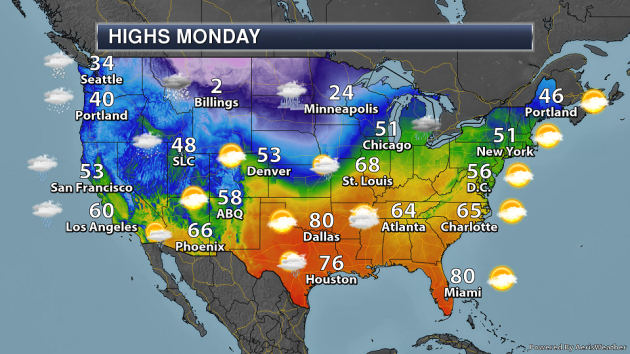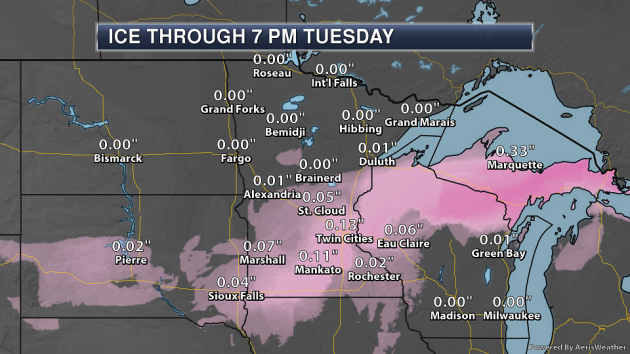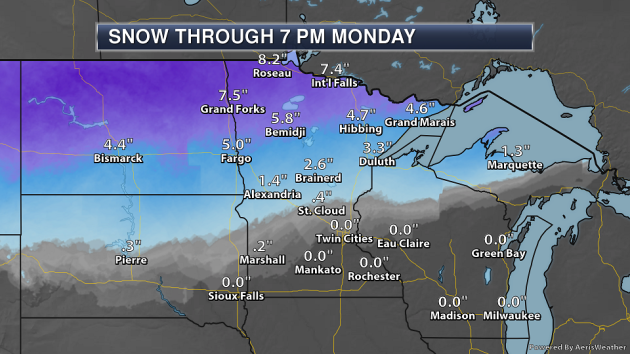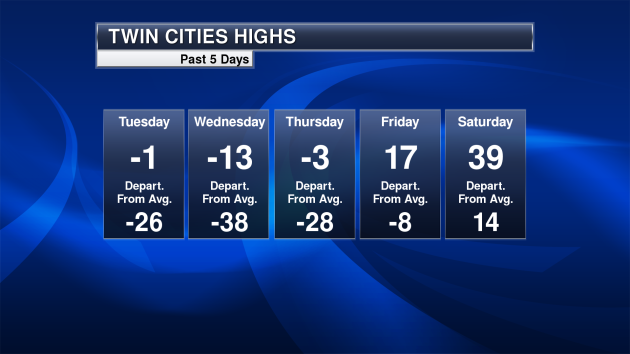National Weather Forecast


On Monday, an area of low pressure and associated fronts will bring rain from parts of the Great Lakes into the Deep South, with a icy mixture in parts of the upper Midwest and heavy snow from North Dakota to northern MInnesota. This will also produce some precipitation across northern New England. A mess of rain and snow is also expected out west. Highs will be over 30-degrees below average across parts of the Northern Plains and Northern Rockies, meanwhile they will be a good 15-30 degrees above average across parts of the mid-section of the country.

Heavy precipitation will continue across the west coast, with up to 3″ of rain possible in spots – and even higher amounts of melted precipitation in the Sierra.

Four to eight feet of snow could fall through the first part of the week in the Sierras, with the potential of over a foot as well into parts of the Northern Rockies. Meanwhile, a band of 6″+ of snow will fall from eastern Montana into northern Minnesota Sunday into Monday.
_______________________________________________
Wintry Mix Of Precipitation Sunday Night Into Monday

An area of icy weather is expected across southern Minnesota into western Wisconsin Sunday Night into Monday as an area of low pressure slides across the region. At the same time, a mid-level disturbance will bring snow – heavy at times – across North Dakota into Minnesota.


_______________________________________________
Recent Temperature Rollercoaster

It’s been a wild past few days temperature-wise here in the Twin Cities. Here’s a look at highs between Tuesday and Saturday – a swing from -13F on Wednesday (a whopping 38 degrees below average) to a snow-melting high of 39F on Saturday.
_______________________________________________
Nepalese Rice Farmers Boost Yields By Sowing Fewer Plants And Cutting Water
More from NPR: “Apsara Bharati and her neighbors are spread across a small bit of land in Kavre, about 20 miles outside Kathmandu, Nepal’s capital. The women bend to plant rice seedlings in mud up to their calves in Bharati’s field. “One by one,” Bharati instructs the women, who are used to placing several plants at once. Bharati is practicing SRI, or the system of rice intensification. The technique, which was developed in Madagascar in the 1980s by French Jesuit priest Henri de Laulanié, involves several practices that seem counterintuitive to increasing production, such as planting fewer seedlings, planting them younger and using less water. But small farmers across the world have reported massive gains in yield that they attribute to the process. A Warming Planet Could Zap Nutrition From Rice That Feeds The World THE SALT A Warming Planet Could Zap Nutrition From Rice That Feeds The World Farmers using SRI in Nepal have consistently doubled their yields, according to Rajendra Uprety, a senior agriculture extension officer in southern Nepal and a pioneer of the practice in the country. This can make a huge difference for small landholders who rely on what they grow for months out of the year. Uprety says by using SRI, farmers can triple their income by growing more expensive varieties that they would otherwise eschew because of low yields. SRI also cuts water demand, which is becoming increasingly important as climate change causes worries about scarcity and food security.”
Hurricane Katrina’s aftermath included spike in heart disease hospitalizations
More from ScienceDaily: “Natural disasters such as earthquakes, tornados, and hurricanes are generally described in terms of wind speed, land area, and inches of rain. They’re also described in terms of human costs, such as the number of fatalities and injuries. Hurricane Katrina, for example, led to approximately 1,000 deaths in Louisiana, of which 75 percent were among adults age 60 or above. What are the hidden health costs, though, that might not be reported immediately, but which are a result of a natural disaster? Some studies have looked at stress disorders, but a new study from researchers and scholars at Tufts University examined changes in the number of cardiovascular disease (CVD) hospitalizations before and after Katrina, and the disparate effect of Katrina on black and white older adults in Louisiana. The co-first author on the study is Ninon Becquart, a former scholar in the NIH-funded Post-Baccalaureate Research Program (PREP) at Tufts who used R, SQL, and ArcMap to conduct sophisticated data analysis, including visualization. She was mentored on the research project by Elena Naumova, chair of the Division of Nutrition Data Science at the Friedman School of Nutrition Science and Policy at Tufts.”
Climate change 2020: can the Democrats make it an election issue?
More from The Guardian: “Such ideas could now form the backbone of a national strategy that more and more Democrats are supporting and which will also aim to help slow the pace of climate change: a Green New Deal. The concept has the backing of the 2020 presidential contenders Cory Booker, Kirsten Gillibrand, Kamala Harris, and Elizabeth Warren and the likely candidate Bernie Sanders. The New York representative Alexandria Ocasio-Cortez and Massachusetts senator Ed Markey will soon roll out a brief outline. A Green New Deal will aim to spur jobs and tackle inequity. It will aim to help people of color and indigenous communities. And it will try to help places like Benham, Kentucky. But most importantly, people involved say, the document will push candidates for the White House to explain what they plan to do about climate change.”
_______________________________________________
Thanks for checking in and have a great Monday! Don’t forget to follow me on Twitter (@dkayserwx) and like me on Facebook (Meteorologist D.J. Kayser)!
– D.J. Kayser


